Charles E W Bean, Diaries, AWM38 3DRL 606/265/1 - 1916 - 1938 - Part 6
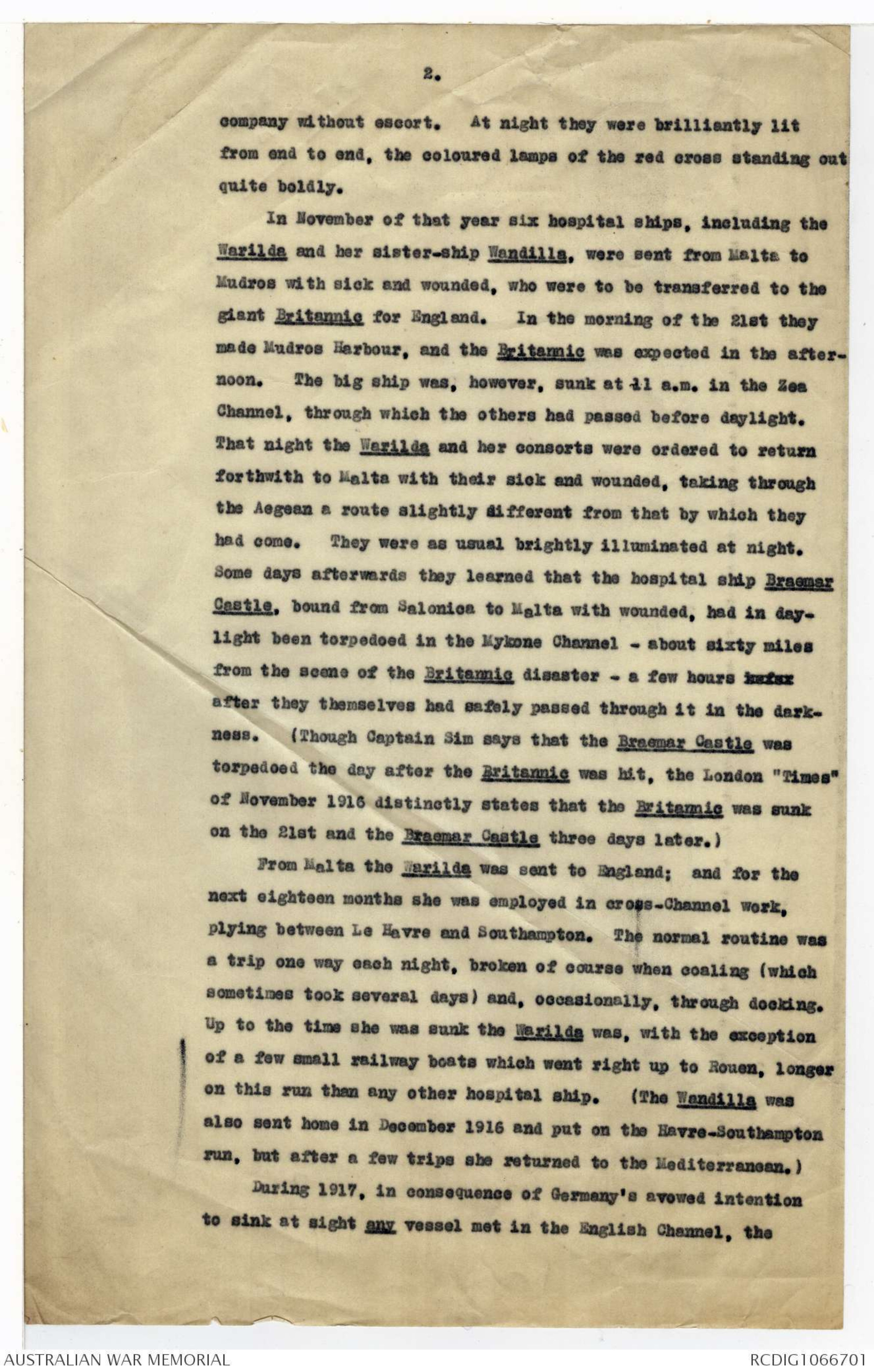

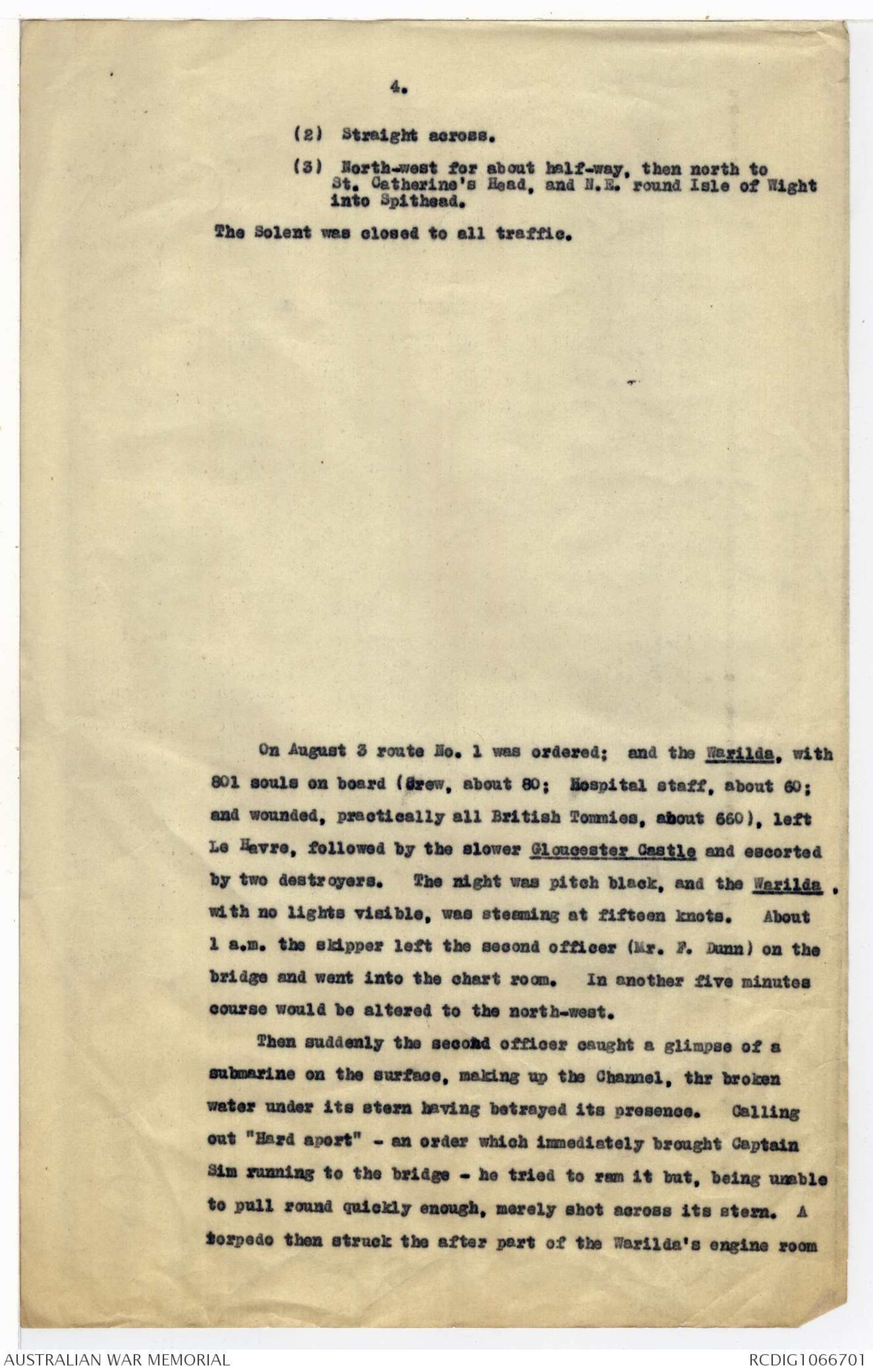
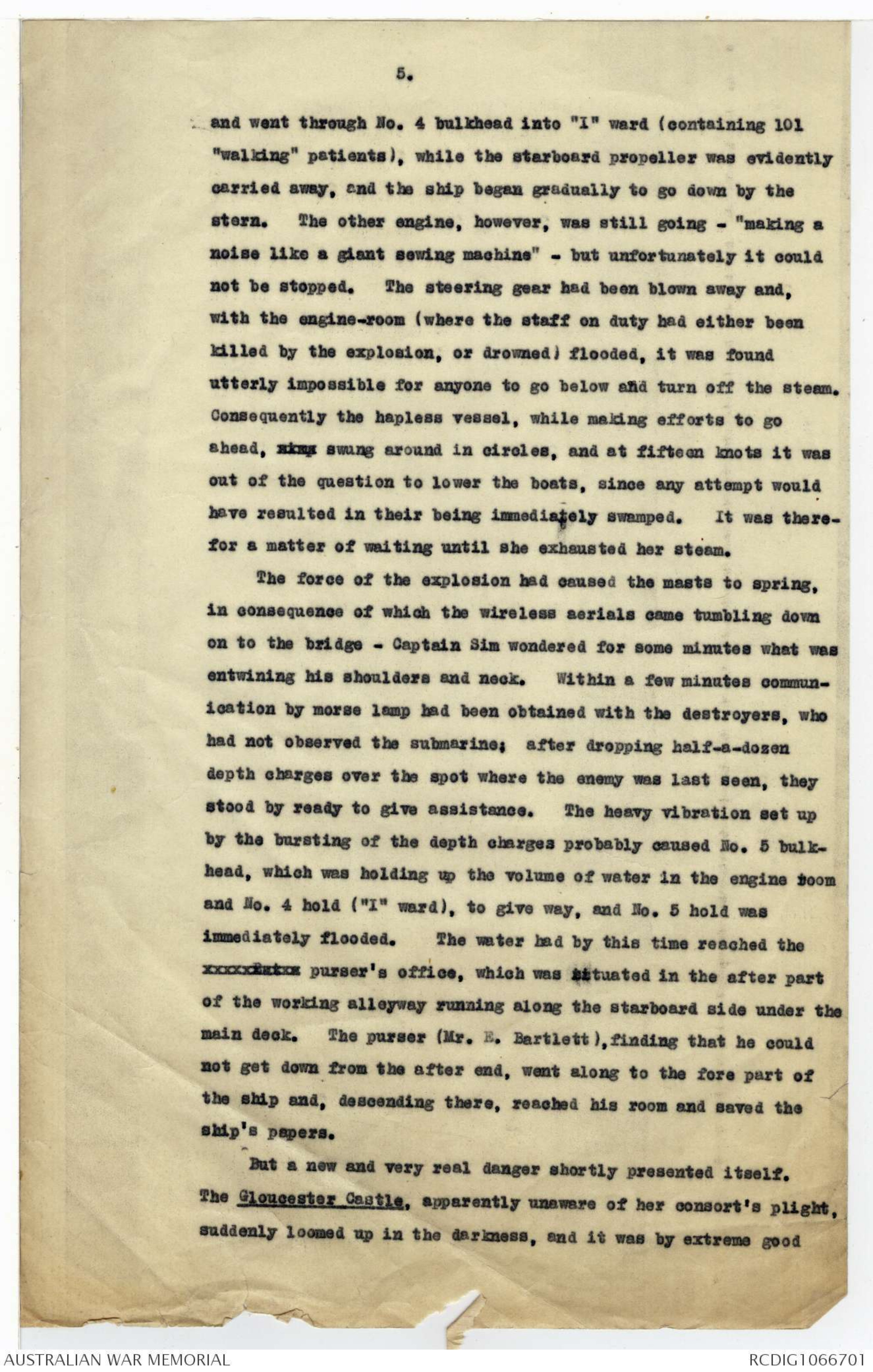
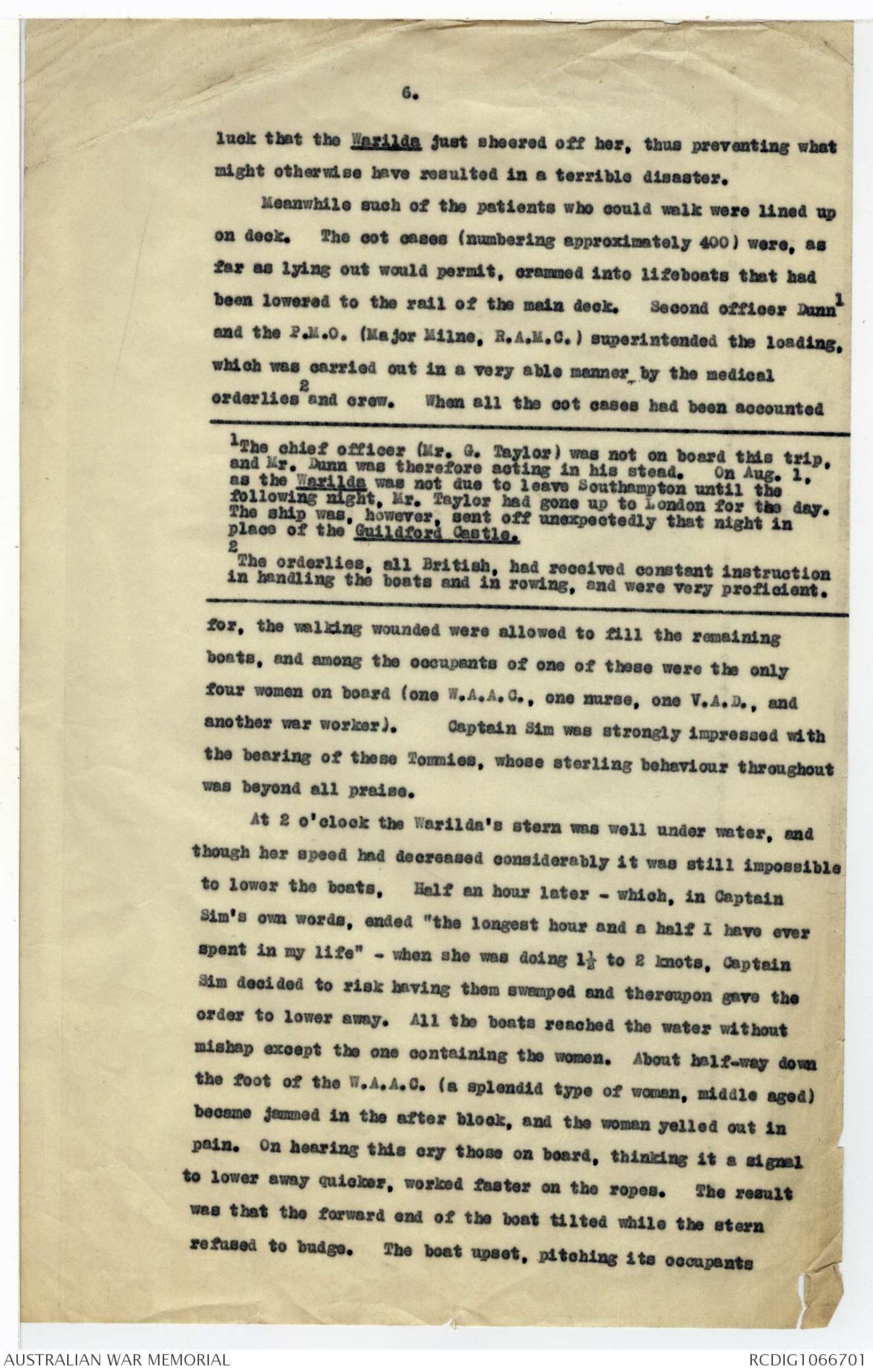

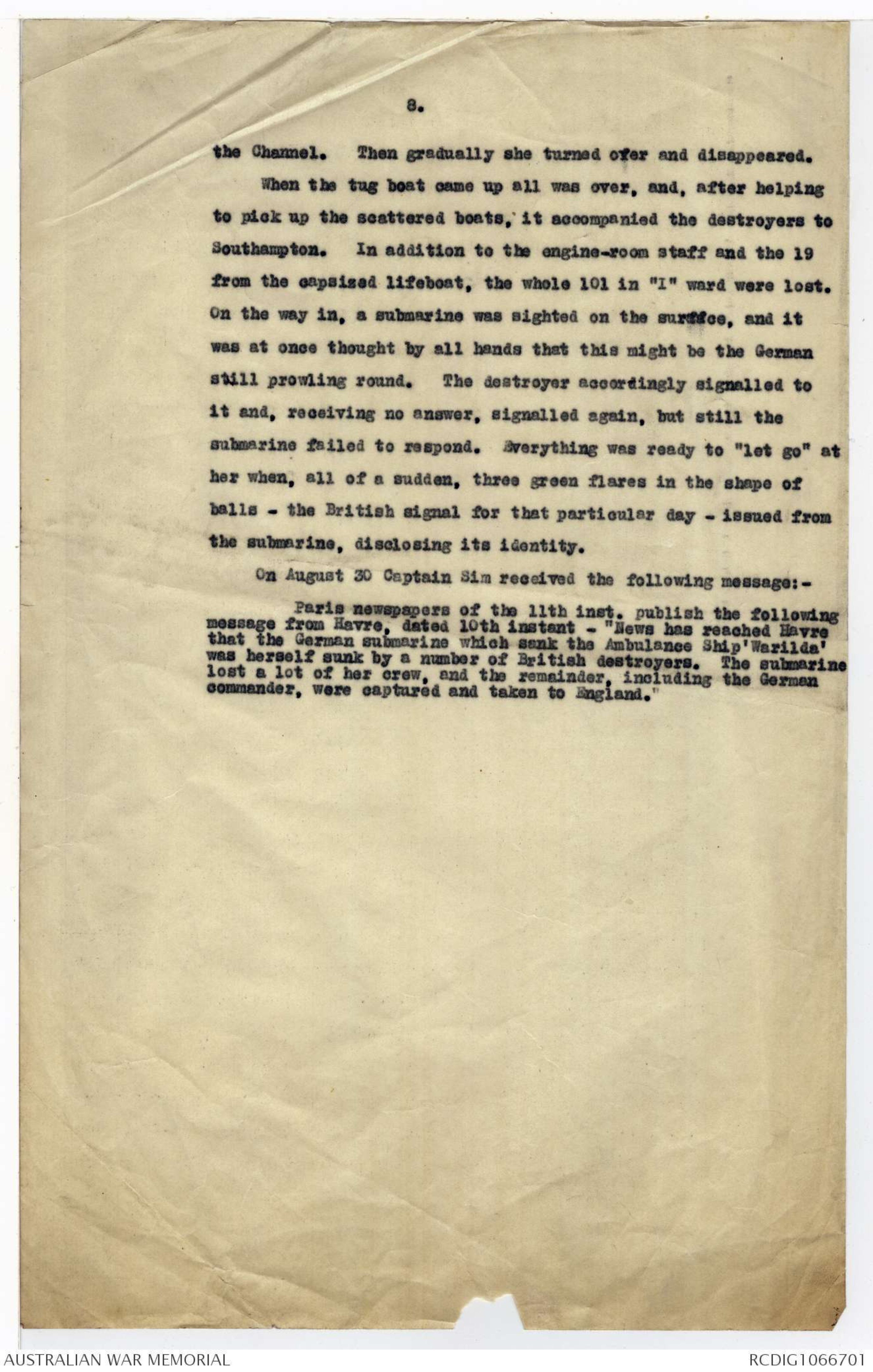
2.
company without escort. At night they were brilliantly lit
from end to end, the coloured lamps of the red cross standing out
quite boldly.
In November of that year six hospital ships, including the
Warilda and her sister-ship Wandilla, were sent from Malta to
Mudros with sick and wounded, who were to be transferred to the
giant Britannic for England. In the morning of the 21st they
made Mudros Harbour, and the Britannic was expected in the afternoon.
The big ship was; however, sunk at at 11 a.m. in the Zea
Channel, through which the others had passed before daylight.
That night the Warilda and her consorts were ordered to return
forthwith to Malta with their sick and wounded, taking through
the Aegean a route slightly different from that by which they
had come. They were as usual brightly illuminated at night.
Some days afterwards they learned that the hospital ship Braemar
Castle, bound from Salonica to Malta with wounded, had in daylight
been torpedoed in the Mykone Channel - about sixty miles
from the scene of the Britannic disaster - a few hours before
after they themselves had safely passed through it in the darkness.
(Though Captain Sim says that the Braemar Castle was
torpedoed the day after the Britannic was hit, the London "Times"
of November 1916 distinctly states that the Britannic was sunk
on the 21st and the Braemar Castle three days later.)
From Malta the Warilda was sent to England; and for the
next eighteen months she was employed in cross-Channel work,
plying between Le Havre and Southampton. The normal routine was
a trip one way each night, broken of course when coaling (which
sometimes took several days) and, occasionally, through docking.
Up to the time she was sunk the Warilda was, with the exception
of a few small railway boats which went right up to Rouen, longer
on this run than any other hospital ship. (The Wandilla was
also sent home in December 1916 and put on the Havre-Southampton
run, but after a few trips she returned to the Mediterranean.)
During 1917, in consequence of Germany's avowed intention
to sink at sight any vessel met in the English Channel, the
3.
Admiralty decided that all distinctive exterior markings should
be removed from hospital ships running in that area. The ships
were accordingly repainted, camouflaged, armed with a 4.5 gun at
the stern, and bore every semblance to an ordinary merchant ship
or transport. Henceforth they were known as "Ambulance
transports". A reward of £1,000 had for some time past been
paid for every submarine caught or destroyed.
On one occasion 500 German officers -who were being sent
to Switzerland to be exchanged for a like number of British
Officers - were taken across to Le Havre by the Warilda. The
Germans, learning that dinner would be served at 6 p.m., protested
that they were used to having this meal at 7 o'clock. Captain
Sim went below and, meeting their spokesman - a well dressed
officer wearing an eyeglass - told him in no uncertain terms
that dinner would be on the table at six and those who failed to
put in an appearance at that hour would get nothing to eat in
his ship. Needless to say there was a full muster. (? Were
all these Germans officers)
,In February 1918 the Warilda, with a full load of wounded,
narrowly missed being sunk. The night was dark, and about 2
a.m. the wake of a torpedo was seen quite close on the starboard
side. Almost at once she was hit, the torpedo driving in a
plate abreast of No. 3 hatch, abaft the bridge, but failing to
explode. The submarine was not seen.
During 1918 Captain Sim was given a month's leave; and
one night during his absence the Warilda, when off St. Catherine's
Head (Isle of Wight), collided with a French steamer which
was under charter to the British Government. The latter was
seriously damaged and, in order to save her from sinking, she
had to be run ashore in St. Helen's Bay.
The Warilda was sunk on 3 August 1918. Three routes were
laid down for ships on the Havre-Southampton run. These,
roughly speaking, were:-
(1) Due north for about half-way, and then north-west.
4.
(2) Straight across.
(3) North-west for about half-way, then north to
St. Catherine's Head, and N.E. round Isle of Wight
into Spithead.
The Solent was closed to all traffic.
On August 3 route No. 1 was ordered; and the Warilda, with
801 souls on board (Crew, about 80; Hospital staff, about 60;
and wounded, practically all British Tommies, about 660), left
Le Havre, followed by the slower Gloucester Castle and escorted
by two destroyers. The night was pitch black, and the Warilda,
with no lights visible, was steaming at fifteen knots. About
1 a.m. the skipper left the second officer (Mr. F. Dunn) on the
bridge and went into the chart room. In another five minutes
course would be altered to the north-west.
Then suddenly the second officer caught a glimpse of a
submarine on the surface, making up the Channel, thr broken
water under its stern having betrayed its presence. Calling
out "Hard aport" - an order which immediately brought Captain
Sim running to the bridge - he tried to ram it but, being unable
to pull round quickly enough, merely shot across its stern. A
torpedo then struck the after part of the Warilda's engine room
5.
and went through No. 4 bulkhead into "I" ward (containing 101
"walking" patients), while the starboard propeller was evidently
carried away, and the ship began gradually to go down by the
stern. The other engine, however; was still going - "making a
noise like a giant sewing machine" - but unfortunately it could
not be stopped. The steering gear had been blown away and,
with the engine-room (where the staff on duty had either been
killed by the explosion, or drowned) flooded, it was found
utterly impossible for anyone to go below and turn off the steam.
Consequently the hapless vessel, while making efforts to go
ahead, xxxx swung around in circles, and at fifteen knots it was
out of the question to lower the boats, since any attempt would
have resulted in their being immediately swamped. It was therefor
a matter of waiting until she exhausted her steam.
The force of the explosion had caused the masts to spring,
in consequence of which the wireless aerials came tumbling down
on to the bridge - Captain Sim wondered for some minutes what was
entwining his shoulders and neck. Within a few minutes communication
by morse lamp had been obtained with the destroyers, who
had not observed the submarine; after dropping half-a-dozen
depth charges over the spot where the enemy was last seen, they
stood by ready to give assistance. The heavy vibration set up
by the bursting of the depth charges probably caused No. 5 bulkhead,
which was holding up the volume of water in the engine room
and No. 4 hold ("I" ward), to give way, and No. 5 hold was
immediately flooded. The water had by this time reached thexxxxxxxxxx purser's office, which was situated in the after part
of the working alleyway running along the starboard side under the
main deck. The purser (Mr. E. Bartlett), finding that he could
not get down from the after end, went along to the fore part of
the ship and, descending there, reached his room and saved the
ship's papers.
But a new and very real danger shortly presented itself.
The Gloucester Castle, apparently unaware of her consort's plight,
suddenly loomed up in the darkness, and it was by extreme good
6.
luck that the Warilda just sheered off her, thus preventing what
might otherwise have resulted in a terrible disaster.
Meanwhile such of the patients who could walk were lined up
on deck. The cot cases (numbering approximately 400) were, as
far as lying out would permit, crammed into lifeboats that had
been lowered to the rail of the main deck. Second officer Dunn1
and the P.M.O. (Major Milne, R.A.M.C.) superintended the loading,
which was carried out in a very able manner by the medical
orderlies2 and crew. When all the cot cases had been accounted
1The chief officer (Mr. G. Taylor) was not on board this trip,
and Mr. Dunn was therefore acting in his stead. On Aug. 1,
as the Warilda was not due to leave Southampton until the
following night, Mr. Taylor had gone up to London for the day.
The ship was, however, sent off unexpectedly that night in
place of the Guildford Castle.
2The orderlies, all British, had received constant instruction
in handling the boats and in rowing, and were very proficient.
for, the walking wounded were allowed to fill the remaining
boats, and among the occupants of one of these were the only
four women on board (one W.A.A.C., one nurse, one V.A.D., and
another war worker). Captain Sim was strongly impressed with
the bearing of these Tommies, whose sterling behaviour throughout
was beyond all praise.
At 2 o'clock the Warilda's stern was well under water, and
though her speed had decreased considerably it was still impossible
to lower the boats, Half an hour later - which, in Captain
Sim's own words, ended "the longest hour and a half I have ever
spent in my life" - when she was doing 1½ to 2 knots, Captain
Sim decided to risk having them swamped and thereupon gave the
order to lower away. All the boats reached the water without
mishap except the one containing the women. About half-way down
the foot of the W.A.A.C. (a splendid type of woman, middle aged)
became jammed in the after block, and the woman yelled out in
pain. On hearing this cry those on board, thinking it a signal
to lower away quicker, worked faster on the ropes. The result
was that the forward end of the boat tilted while the stern
refused to budge. The boat upset, pitching its occupants
7.
headlong into the water. All but 19 - including the unfortunate
W.A.A.C., whose leg had been wrenched off at the thigh - were
saved by the other lifeboats and the destroyers. The V.A.D. -
a young English girl, about 20, who should have gone on leave the
previous day but who, being a friend of Captain Sim's sister
(then on the staff of the 2nd A.G.H. in France), waited to go on
the Warilda - thinking an ambulance transport would be quite safe
had, against regulations; undressed and gone to bed, and when the
ship was hit had come up in her nightgown, in which attire she
remained. Realizing that the lifeboat was going to capsize she,
a good swimmer, whipped off her gown and dived into the sea. Late
Later on the captain of one of the destroyers told Captain Sim
that, on seeing an object floating by, be had made a grab and
pulled up by the hair what, for a moment, he through thought was
a mermaid! The little V.A.D. was provided with a man's vest
and pants, and appeared none the worse for her immersion.
Although earlier a message had been wirelessed to Southampton
asking for a tugboat to be despatched to the scene, Captain Sim
now felt that there was no hope of saving his ship which, with
her stern right down, was inclining at a big angle. By this time
the destroyers were able to get alongside and take off those who,
because of the extra space taken up by the cot cases, had not
found room in the boats. The chief engineer (Mr. C.E. Young),
second officer, and captain were the last to leave, though Captain
Sim had a narrow escape from being left behind. As he passed
from the bridge in the dark he tripped over a raft (none of which
it was found necessary to use) lying across the deck and cannoned
heavily against the barrel of a winch. This knocked the wind out
of him, and for a moment he thought he would have to stay; but,
keeping his senses, he struggled to the side and slid down one of
the lifeboat falls on to the deck of the destroyer. Less than
five minutes after they had cleared her the Warilda's bow shot up
into the air, and a few seconds later those on the destroyer
realized by the way it shivered that she had struck the bottom of
8.
the Channel. Then gradually she turned over and disappeared.
When the tug boat came up all was over, and, after helping
to pick up the scattered boats, it accompanied the destroyers to
Southampton. In addition to the engine-room staff and the 19
from the capsized lifeboat, the whole 101 in "I" ward were lost.
On the way in, a submarine was sighted on the surface, and it
was at once thought by all hands that this might be the German
still prowling round. The destroyer accordingly signalled to
it and, receiving no answer, signalled again, but still the
submarine failed to respond. Everything was ready to "let go” at
her when, all of a sudden, three green flares in the shape of
balls - the British signal for that particular day - issued from
the submarine, disclosing its identity.
On August 30 Captain Sim received the following message:-
Paris newspapers of the 11th inst. publish the following
message from Havre; dated 10th instant - "News has reached Havre
that the German submarine which sank the Ambulance Ship'Warilda'
was herself sunk by a number of British destroyers. The submarine
lost a lot of her crew, and the remainder, including the German
commander, were captured and taken to England."
 Marisa Bortolotto
Marisa BortolottoThis transcription item is now locked to you for editing. To release the lock either Save your changes or Cancel.
This lock will be automatically released after 60 minutes of inactivity.